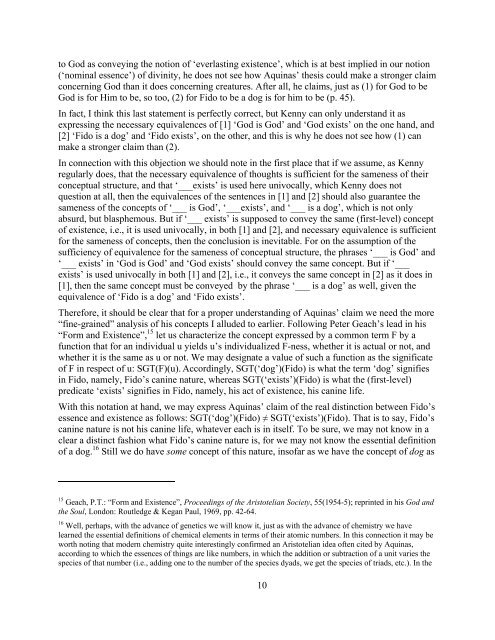On Kenny on Aquinas on Being - Fordham University Faculty
On Kenny on Aquinas on Being - Fordham University Faculty
On Kenny on Aquinas on Being - Fordham University Faculty
- No tags were found...
Create successful ePaper yourself
Turn your PDF publications into a flip-book with our unique Google optimized e-Paper software.
to God as c<strong>on</strong>veying the noti<strong>on</strong> of ‘everlasting existence’, which is at best implied in our noti<strong>on</strong>(‘nominal essence’) of divinity, he does not see how <strong>Aquinas</strong>’ thesis could make a str<strong>on</strong>ger claimc<strong>on</strong>cerning God than it does c<strong>on</strong>cerning creatures. After all, he claims, just as (1) for God to beGod is for Him to be, so too, (2) for Fido to be a dog is for him to be (p. 45).In fact, I think this last statement is perfectly correct, but <str<strong>on</strong>g>Kenny</str<strong>on</strong>g> can <strong>on</strong>ly understand it asexpressing the necessary equivalences of [1] ‘God is God’ and ‘God exists’ <strong>on</strong> the <strong>on</strong>e hand, and[2] ‘Fido is a dog’ and ‘Fido exists’, <strong>on</strong> the other, and this is why he does not see how (1) canmake a str<strong>on</strong>ger claim than (2).In c<strong>on</strong>necti<strong>on</strong> with this objecti<strong>on</strong> we should note in the first place that if we assume, as <str<strong>on</strong>g>Kenny</str<strong>on</strong>g>regularly does, that the necessary equivalence of thoughts is sufficient for the sameness of theirc<strong>on</strong>ceptual structure, and that ‘___exists’ is used here univocally, which <str<strong>on</strong>g>Kenny</str<strong>on</strong>g> does notquesti<strong>on</strong> at all, then the equivalences of the sentences in [1] and [2] should also guarantee thesameness of the c<strong>on</strong>cepts of ‘___ is God’, ‘___exists’, and ‘___ is a dog’, which is not <strong>on</strong>lyabsurd, but blasphemous. But if ‘___ exists’ is supposed to c<strong>on</strong>vey the same (first-level) c<strong>on</strong>ceptof existence, i.e., it is used univocally, in both [1] and [2], and necessary equivalence is sufficientfor the sameness of c<strong>on</strong>cepts, then the c<strong>on</strong>clusi<strong>on</strong> is inevitable. For <strong>on</strong> the assumpti<strong>on</strong> of thesufficiency of equivalence for the sameness of c<strong>on</strong>ceptual structure, the phrases ‘___ is God’ and‘___ exists’ in ‘God is God’ and ‘God exists’ should c<strong>on</strong>vey the same c<strong>on</strong>cept. But if ‘___exists’ is used univocally in both [1] and [2], i.e., it c<strong>on</strong>veys the same c<strong>on</strong>cept in [2] as it does in[1], then the same c<strong>on</strong>cept must be c<strong>on</strong>veyed by the phrase ‘___ is a dog’ as well, given theequivalence of ‘Fido is a dog’ and ‘Fido exists’.Therefore, it should be clear that for a proper understanding of <strong>Aquinas</strong>’ claim we need the more“fine-grained” analysis of his c<strong>on</strong>cepts I alluded to earlier. Following Peter Geach’s lead in his“Form and Existence”, 15 let us characterize the c<strong>on</strong>cept expressed by a comm<strong>on</strong> term F by afuncti<strong>on</strong> that for an individual u yields u’s individualized F-ness, whether it is actual or not, andwhether it is the same as u or not. We may designate a value of such a functi<strong>on</strong> as the significateof F in respect of u: SGT(F)(u). Accordingly, SGT(‘dog’)(Fido) is what the term ‘dog’ signifiesin Fido, namely, Fido’s canine nature, whereas SGT(‘exists’)(Fido) is what the (first-level)predicate ‘exists’ signifies in Fido, namely, his act of existence, his canine life.With this notati<strong>on</strong> at hand, we may express <strong>Aquinas</strong>’ claim of the real distincti<strong>on</strong> between Fido’sessence and existence as follows: SGT(‘dog’)(Fido) ≠ SGT(‘exists’)(Fido). That is to say, Fido’scanine nature is not his canine life, whatever each is in itself. To be sure, we may not know in aclear a distinct fashi<strong>on</strong> what Fido’s canine nature is, for we may not know the essential definiti<strong>on</strong>of a dog. 16 Still we do have some c<strong>on</strong>cept of this nature, insofar as we have the c<strong>on</strong>cept of dog as15 Geach, P.T.: “Form and Existence”, Proceedings of the Aristotelian Society, 55(1954-5); reprinted in his God andthe Soul, L<strong>on</strong>d<strong>on</strong>: Routledge & Kegan Paul, 1969, pp. 42-64.16 Well, perhaps, with the advance of genetics we will know it, just as with the advance of chemistry we havelearned the essential definiti<strong>on</strong>s of chemical elements in terms of their atomic numbers. In this c<strong>on</strong>necti<strong>on</strong> it may beworth noting that modern chemistry quite interestingly c<strong>on</strong>firmed an Aristotelian idea often cited by <strong>Aquinas</strong>,according to which the essences of things are like numbers, in which the additi<strong>on</strong> or subtracti<strong>on</strong> of a unit varies thespecies of that number (i.e., adding <strong>on</strong>e to the number of the species dyads, we get the species of triads, etc.). In the10
















